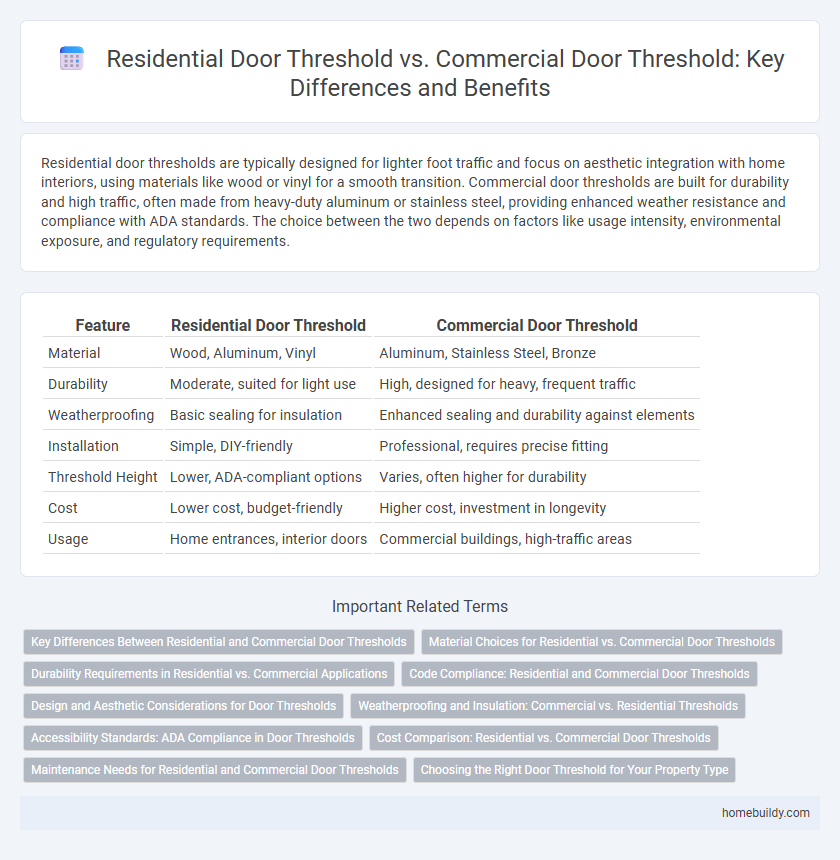Residential door thresholds are typically designed for lighter foot traffic and focus on aesthetic integration with home interiors, using materials like wood or vinyl for a smooth transition. Commercial door thresholds are built for durability and high traffic, often made from heavy-duty aluminum or stainless steel, providing enhanced weather resistance and compliance with ADA standards. The choice between the two depends on factors like usage intensity, environmental exposure, and regulatory requirements.
Table of Comparison
| Feature | Residential Door Threshold | Commercial Door Threshold |
|---|---|---|
| Material | Wood, Aluminum, Vinyl | Aluminum, Stainless Steel, Bronze |
| Durability | Moderate, suited for light use | High, designed for heavy, frequent traffic |
| Weatherproofing | Basic sealing for insulation | Enhanced sealing and durability against elements |
| Installation | Simple, DIY-friendly | Professional, requires precise fitting |
| Threshold Height | Lower, ADA-compliant options | Varies, often higher for durability |
| Cost | Lower cost, budget-friendly | Higher cost, investment in longevity |
| Usage | Home entrances, interior doors | Commercial buildings, high-traffic areas |
Key Differences Between Residential and Commercial Door Thresholds
Residential door thresholds are designed primarily for aesthetic appeal and basic weather sealing, featuring materials like wood or aluminum with simpler profiles. Commercial door thresholds prioritize durability and accessibility, often constructed from heavy-duty aluminum or stainless steel with reinforced edges to withstand high foot traffic and meet ADA compliance standards. Additionally, commercial thresholds incorporate features such as beveled edges and enhanced weather resistance to accommodate diverse entryways and ensure safety in public spaces.
Material Choices for Residential vs. Commercial Door Thresholds
Residential door thresholds commonly use materials like wood, aluminum, or vinyl, chosen for aesthetic appeal and moderate durability. Commercial door thresholds prioritize heavy-duty materials such as stainless steel, bronze, or reinforced aluminum to withstand high foot traffic and comply with accessibility standards. The material selection impacts durability, maintenance, and weather resistance specific to the usage environment.
Durability Requirements in Residential vs. Commercial Applications
Residential door thresholds must balance moderate durability with aesthetic appeal, typically constructed from aluminum or wood to withstand daily home use. Commercial door thresholds require enhanced durability, often made from heavy-duty metals like stainless steel or reinforced aluminum to endure high traffic, frequent opening and closing, and exposure to varying weather conditions. The difference in durability requirements reflects the intensity of use, with commercial thresholds designed for prolonged wear and resistance to impacts, while residential thresholds prioritize comfort and integration with home design.
Code Compliance: Residential and Commercial Door Thresholds
Residential door thresholds must comply with the International Residential Code (IRC), ensuring proper weather sealing, accessibility standards under the Americans with Disabilities Act (ADA), and fire safety regulations. Commercial door thresholds adhere to the International Building Code (IBC) requirements, emphasizing durability, load-bearing capacity, and stricter ADA accessibility criteria for public buildings. Both residential and commercial thresholds are subject to local amendments, making verification of specific code compliance essential during installation.
Design and Aesthetic Considerations for Door Thresholds
Residential door thresholds often feature sleek, low-profile designs that seamlessly blend with interior flooring materials, enhancing home aesthetics with wood, aluminum, or vinyl options. Commercial door thresholds prioritize durability and functionality, utilizing heavy-duty materials like stainless steel or reinforced rubber to withstand high traffic while maintaining a professional appearance. Design considerations for both types emphasize smooth transitions, accessibility compliance, and weather sealing, but residential options focus more on elegance, whereas commercial thresholds emphasize robust performance and safety.
Weatherproofing and Insulation: Commercial vs. Residential Thresholds
Commercial door thresholds often feature heavy-duty materials and enhanced weatherproofing seals designed to withstand high foot traffic and extreme weather conditions, providing superior insulation. Residential door thresholds prioritize energy efficiency and thermal insulation to reduce heating and cooling costs, typically incorporating foam or rubber gaskets to prevent drafts and moisture ingress. The difference in design reflects the commercial need for durability and protection against harsher environments compared to residential emphasis on comfort and energy savings.
Accessibility Standards: ADA Compliance in Door Thresholds
Residential door thresholds typically have lower height requirements and more flexible design standards compared to commercial door thresholds, which must strictly comply with ADA accessibility guidelines. Commercial door thresholds are designed to minimize trip hazards and allow smooth wheelchair transitions, often featuring maximum height limits of 1/2 inch with beveled edges. Compliance with ADA ensures safer access in public buildings, where thresholds must accommodate wider ranges of users and meet precise dimensional and material criteria.
Cost Comparison: Residential vs. Commercial Door Thresholds
Residential door thresholds typically cost between $20 and $50 due to simpler materials and smaller sizes, while commercial door thresholds can range from $100 to $300 or more because of heavy-duty materials like aluminum or stainless steel designed for higher traffic. Installation costs for commercial thresholds are generally higher, reflecting the need for professional fitting and compliance with ADA regulations. The durability and enhanced weatherproofing features of commercial thresholds justify their increased price compared to residential options.
Maintenance Needs for Residential and Commercial Door Thresholds
Residential door thresholds typically require less frequent maintenance due to lighter foot traffic and lower exposure to harsh environmental conditions. Commercial door thresholds endure constant usage, necessitating regular inspection, cleaning, and timely repairs to prevent wear and maintain safety standards. Material durability and resistance to heavy abrasion are critical factors influencing the maintenance schedules of commercial thresholds compared to residential ones.
Choosing the Right Door Threshold for Your Property Type
Residential door thresholds are designed primarily for light foot traffic and energy efficiency, often featuring materials like wood or vinyl that blend with home interiors. Commercial door thresholds prioritize durability and ADA compliance, using robust metals such as aluminum or stainless steel to withstand heavy usage and provide slip resistance. Selecting the appropriate door threshold depends on evaluating foot traffic intensity, exposure to weather elements, and building code requirements specific to residential or commercial properties.
residential door threshold vs commercial door threshold Infographic

 homebuildy.com
homebuildy.com